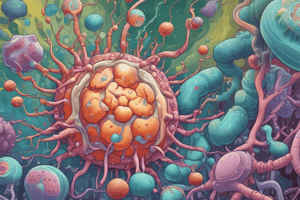Podcast
Questions and Answers
What are the resistance characteristics of Staphylococcus aureus?
What are the resistance characteristics of Staphylococcus aureus?
Resistance to high salt, extreme pH, and temps
What are the features of MRSA and Soft Tissue Infections caused by Staphylococcus aureus?
What are the features of MRSA and Soft Tissue Infections caused by Staphylococcus aureus?
Raised, red, tender, localized lesions; resistant to multiple antibiotics; feature pus and feel hot to touch
What are the pathogenic enzymes produced by Staphylococcus aureus and their functions?
What are the pathogenic enzymes produced by Staphylococcus aureus and their functions?
Coagulase - coagulates plasma; Hyaluronidase - digests hyaluronic acid that binds connective tissue together; Staphylokinase - digests blood clots; Dnase - digests DNA; Lipase - helps to colonize oily skin; Catalase - breaks down H2O2
What is Impetigo and what causes it?
What is Impetigo and what causes it?
What is Staphylococcal Scalded Skin Syndrome (SSSS) and what causes it?
What is Staphylococcal Scalded Skin Syndrome (SSSS) and what causes it?
Flashcards are hidden until you start studying
Study Notes
Resistance Characteristics of Staphylococcus aureus
- Staphylococcus aureus has developed resistance to various antibiotics, including methicillin, making it a significant public health concern.
- Methicillin-resistant Staphylococcus aureus (MRSA) is a type of Staphylococcus aureus that is resistant to methicillin and other beta-lactam antibiotics.
- Resistance to antibiotics is due to the production of beta-lactamases, which break down the beta-lactam ring of antibiotics, rendering them ineffective.
Features of MRSA and Soft Tissue Infections
- MRSA is a major cause of soft tissue infections, including skin and skin structure infections, wound infections, and abscesses.
- Soft tissue infections caused by MRSA are often characterized by purulent discharge, swelling, and pain.
- MRSA is a significant cause of hospital-acquired infections, particularly in patients with weakened immune systems.
Pathogenic Enzymes of Staphylococcus aureus
- Staphylococcus aureus produces several pathogenic enzymes, including coagulase, hyaluronidase, and lipase.
- Coagulase converts fibrinogen to fibrin, leading to the formation of a protective fibrin clot that shields the bacteria from host immune cells.
- Hyaluronidase breaks down hyaluronic acid, a component of connective tissue, allowing the bacteria to spread more easily through tissues.
- Lipase breaks down lipids, providing a source of nutrients for the bacteria.
Impetigo
- Impetigo is a contagious bacterial skin infection caused by Staphylococcus aureus and Streptococcus pyogenes.
- Impetigo is characterized by crusting and weeping sores on the skin, often on the face, arms, and legs.
- The infection is highly contagious and can be spread through skin-to-skin contact or by touching contaminated surfaces.
Staphylococcal Scalded Skin Syndrome (SSSS)
- Staphylococcal Scalded Skin Syndrome (SSSS) is a rare but life-threatening skin infection caused by Staphylococcus aureus.
- SSSS is characterized by a severe, widespread skin rash, often resembling a scalded appearance, with large blisters and peeling skin.
- The infection is caused by the production of exfoliative toxins, which cause the skin to separate and peel away.
Studying That Suits You
Use AI to generate personalized quizzes and flashcards to suit your learning preferences.




